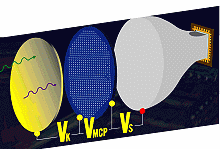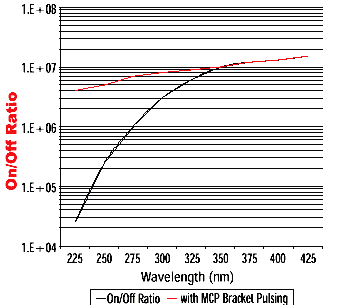

Princeton Instruments PI·MAX is the first commercial ICCD, ( intensified CCD ) camera to provide MCP bracket pulsing in addition to photocathode gating for enhanced light transmission on/off ratio in UV measure-ments.
 MCP bracket pulsing
MCP bracket pulsing
Traditionally,
intensified detectors discriminated against background signal
by gating the photocathode. Although this technique yields very
high peak Off/On ratios, on the order of 5 × 10 6
to 1 in the visible, background signal can still prove troublesome
in low-duty factor measurements, particularly in the UV region
where the rejection is only ~10 4 to 1. The PI·MAX
allows bracket pulsing of the intensifier microchannel plate (MCP),
in addition to the photocathode gating, to gain higher rejection
(10 6 :1) in UV measurements. Applications which can
benefit from this improved design include LIF of flames, and nanosecond
pump-probe experiments. The glass used to make an MCP has the
additional property of exhibiting photoelectric response to UV
photons. Photons transmitted by the photocathode can excite the
release of electrons from the MCP. 'These electrons can be drawn
to and absorbed by the photocathode if it is more positive (i.e.,
off) but some are attracted by the electric field of the MCP and
pass through the MCP's holes, getting multiplied as they go. This
is the dominant response of a GEN Il image intensifier to photons
when the photocathode is electrically "off", i.e., it
is the main source of leakage and thus reduced on/off ratio.
Once electrons emerge from the MCP, they are accelerated to a metal coated phosphor screen by 5 to 6,000 volts. The phosphor screen is metalized both so that it can act as an electrode and to make it optically opaque. The goal however, is for the electrons from the MCP to penetrate the electrode and deposit their energy, creating light which can be coupled to the CCD. If the metal layer is too thick, electrons will not pass through it, if it is too thin, it will be too transparent optically ( like metal reflecting sunglasses). The optimum metal layer is a compromise between these, and this compromise contributes to the high but not infinite on/off ratio of intensifiers.
| Image Intensifier On/Off Ratio vs. Wavelength |
 Once
light is emitted by the phosphor, it is transferred to the CCD
by a fused fiber optic faceplate. These fiber optics are made
of glass (not quartz or fused silica). This allows visible Light
to pass, but not W. Thus purely optical leakage through an intensifier
is much lower in the UV than in the visible. This means that when
UV "leakage-by-MCP-response " is electrically disabled,
an intensifier's on/of ratio actually becomes higher than in the
visible.
Once
light is emitted by the phosphor, it is transferred to the CCD
by a fused fiber optic faceplate. These fiber optics are made
of glass (not quartz or fused silica). This allows visible Light
to pass, but not W. Thus purely optical leakage through an intensifier
is much lower in the UV than in the visible. This means that when
UV "leakage-by-MCP-response " is electrically disabled,
an intensifier's on/of ratio actually becomes higher than in the
visible.
Most experiments
using laser induced fluorescence to probe combusting flows are
performed in the UV. Atomic emission from flames also has significant
UV content. If the flame is continuous, the UV background will
also be continuous. Even where a flame is transient (e.g., internal
combustion engine) its lifetime can be many seconds, compared
to the nanosecond time scale of the lasers used. This background
can last a million times as long. If the background is bright,
then a UV on/off ratio of 20,000: l will be inadequate. For high
dynamic range quantitative measurements, background must be kept
to an absolute um. MCP bracket pulse gating dramatically improves
the rejection of CW and even millisecond-time-scale background